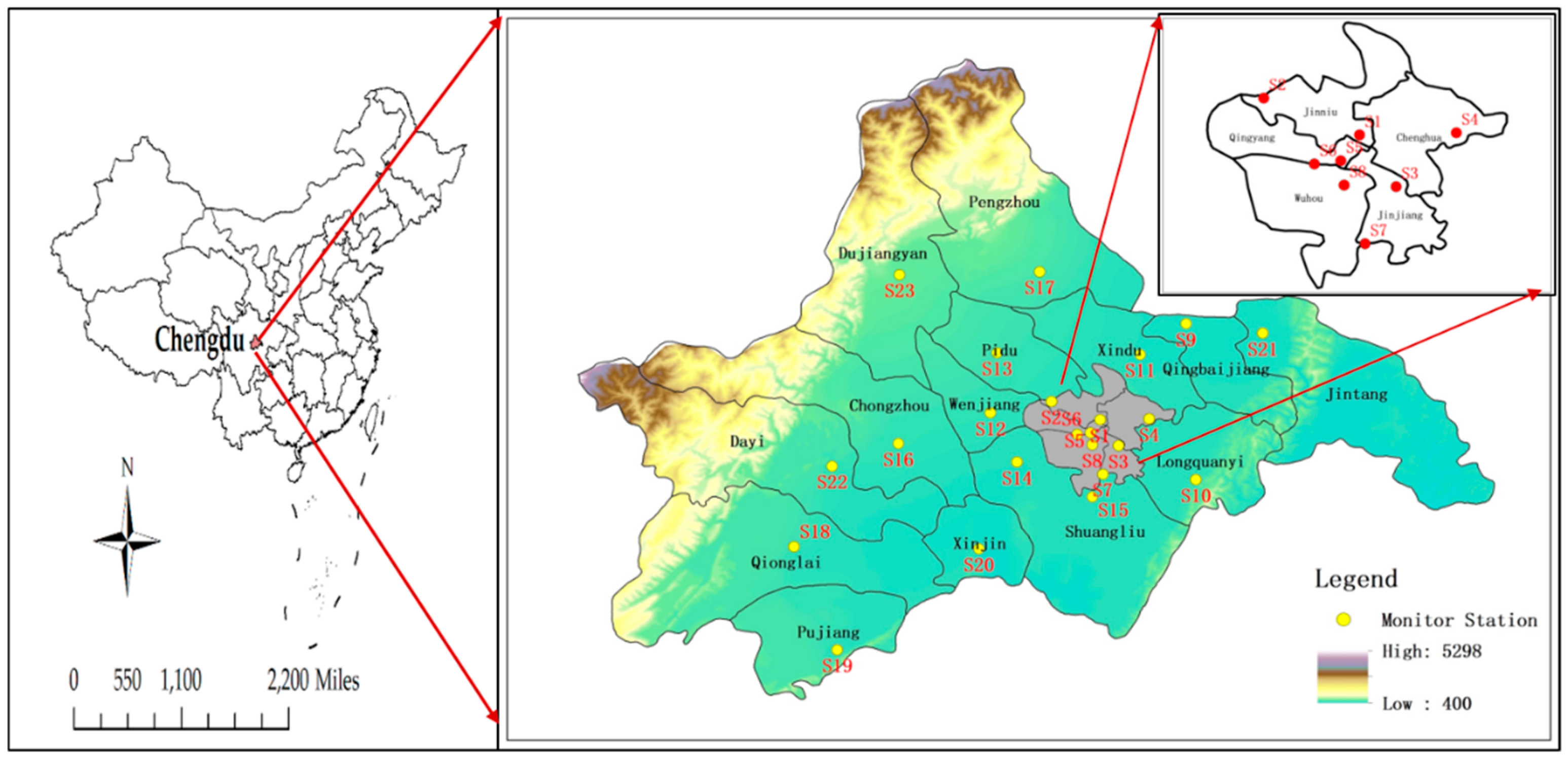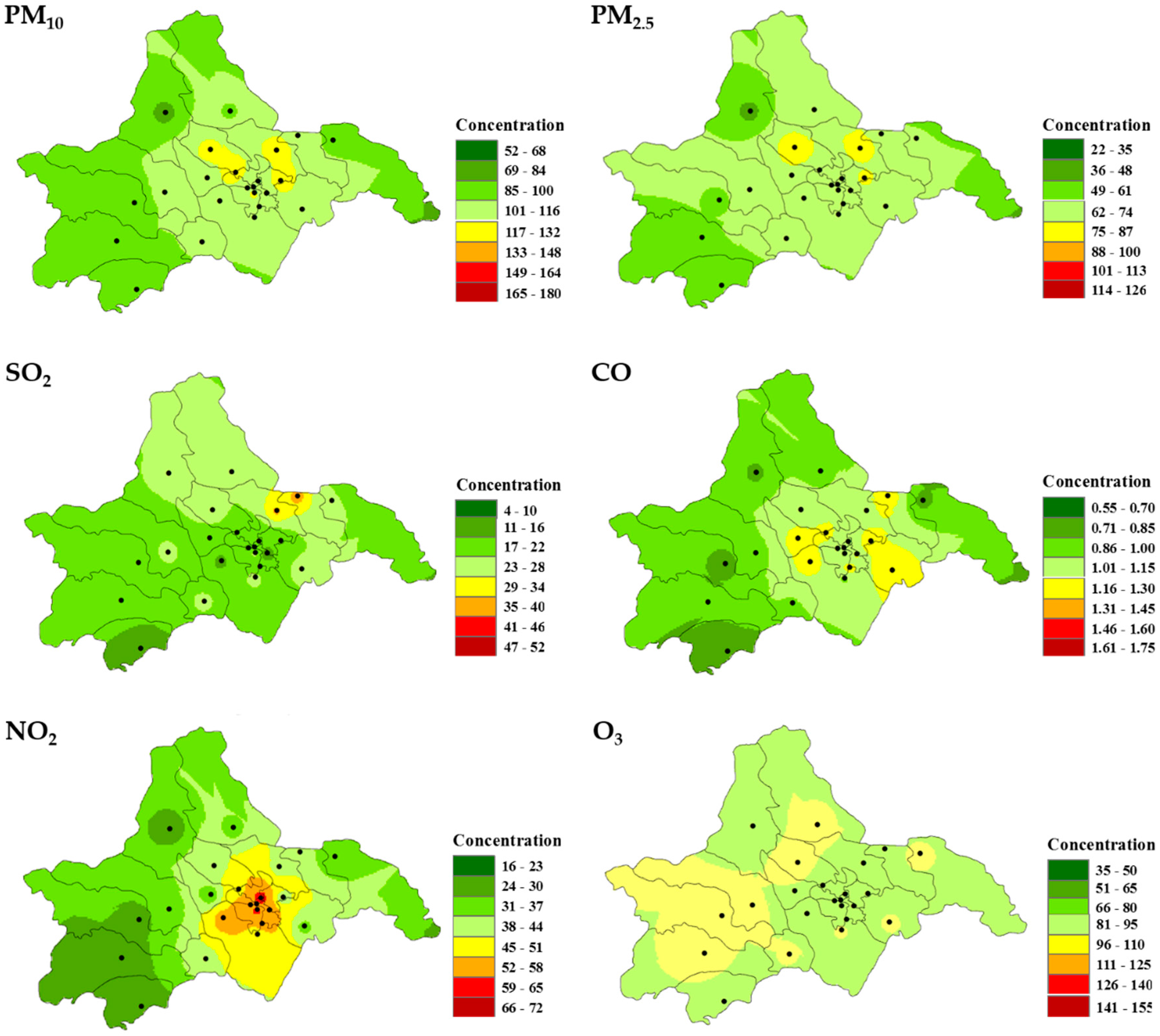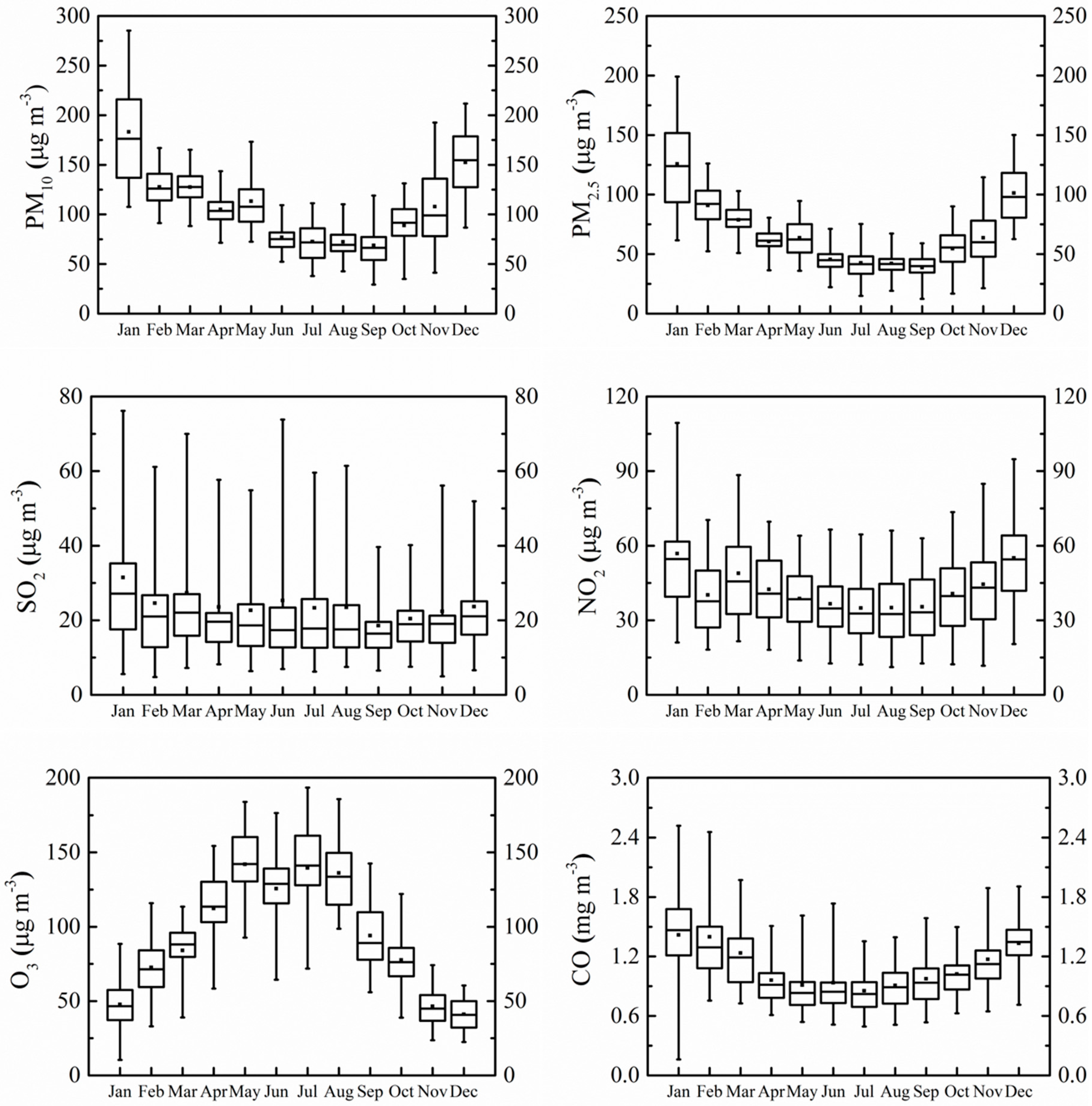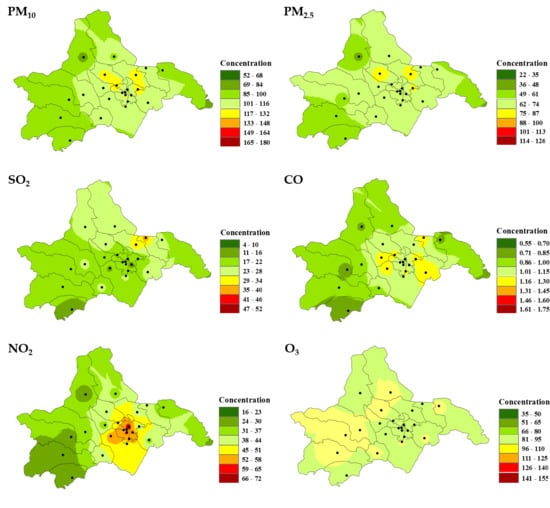Spatiotemporal Characteristics of Air Pollutants (PM10, PM2.5, SO2, NO2, O3, and CO) in the Inland Basin City of Chengdu, Southwest China
Abstract
:1. Introduction
2. Materials and Methods
2.1. Study Area
2.2. Sites, Instruments and Observations
2.3. Methods
3. Results and Discussion
3.1. Air Pollutants Exceeding Standard Levels
3.2. Temporal and Spatial Variations in the Air Pollutants
3.2.1. Spatial Pattern and Inter-Annual Variation in Air Pollutants
3.2.2. Seasonal Variation in Air Pollutants
3.3. Effects of Meteorological Factors on the Air Pollutants
4. Conclusions
- (1)
- Heavy air pollution was induced mainly by high PM or ozone concentrations in Chengdu. The annual mean concentrations of PM2.5 and PM10 exceeded the standards of CAAQS and WHO at all of the stations.
- (2)
- Air pollution was regional in Chengdu, and daily mean CO, NO2, PM2.5, and PM10 inside the middle area (e.g., S1–S8) were much higher than other regions, while daily maximum 8-h average surface O3 concentrations and SO2 were lower inside the middle area. Furthermore, the PM10, PM2.5, SO2, and CO concentrations decreased from 2014 to 2016; the NO2 level basically stable, whereas the O3 level increased markedly during this period.
- (3)
- PM2.5, PM10, SO2, CO, and NO2 displayed the highest levels in winter and the lowest level in summer (SO2 lowest in autumn), indicating the combined impact of industrial sources and unfavorable weather conditions on air pollution dilution and dispersion. However, the O3 concentration peaked in summer, which was associated with the strong solar radiation.
- (4)
- Meteorological conditions are important factors that affect the concentrations of air pollutants in excessive standard days. Haze pollution can be formed easily under the weather conditions of static wind, low temperature, high relative humidity, and high surface pressure inside Chengdu. In contrast, severe ozone pollution is often associated with high temperature.
- (5)
- The results indicate that air pollution in Chengdu is caused by multiple pollutants, and the air pollution shows great divergence in different regions and different seasons. Region-oriented air pollution management plans are suggested. This study also calls for future studies to investigate the associations between air quality and meteorological conditions, emissions in different regions, transport and transformation of pollutants in both intra- and inter-regional contexts, to further improve the understanding of the physical and chemical processes that affect air quality in Chengdu. In addition, we strongly recommend a revision and update of CAAQS standards for SO2, as the difference between the CAAQS and WHO is too large, and the assessment results are also quite different.
Supplementary Materials
Acknowledgments
Author Contributions
Conflicts of Interest
References
- Chen, Y.; Xie, S.D.; Luo, B. Composition and pollution characteristics of fine particles in Chengdu from 2012 to 2013. Aeta Sci. Circumstantiae 2016, 36, 1021–1030. [Google Scholar]
- Chan, C.K.; Yao, X.H. Air pollution in mega cities in China. Atmos. Environ. 2008, 42, 1–42. [Google Scholar] [CrossRef]
- Kan, H.; Chen, R.; Tong, S. Ambient air pollution, climate change, and population health in China. Environ. Int. 2012, 42, 10–19. [Google Scholar] [CrossRef] [PubMed]
- Zhang, Q.; He, K.B.; Huo, H. Policy: Cleaning China’s air. Nature 2012, 484, 161–162. [Google Scholar] [PubMed]
- Alcorn, T. China’s skies: A complex recipe for pollution with no quick fix. Lancet 2013, 381, 1973–1974. [Google Scholar] [CrossRef]
- He, K.B.; Huo, H.; Zhang, Q. Urban air pollution in China: Current status, characteristics, and progress. Annu. Rev. Environ. Resour. 2002, 27, 397–431. [Google Scholar]
- Wang, W.X.; Wang, T. On the origin and the trend of acid precipitation in China. Water Air Soil Pollut. 1995, 85, 2295–2300. [Google Scholar] [CrossRef]
- National Bureau of Statistics of China. China statistical yearbook. 2013. Available online: http://data.stats.gov.cn/workspace/index?m=hgnd (accessed on 8 July 2017).
- Kurokawal, J.; Ohara, T.; Morikawa, S.; Hanayama, S. Emissions of air pollutants and greenhouse gases over Asian regions during 2000–2008: Regional emission inventory in Asia (REAS) version 2. Atmos. Chem. Phys. Discuss. 2013, 13, 10049–10123. [Google Scholar] [CrossRef]
- National Development and Reform Commission. Crucial situations of energy saving and emission reduction, and huge potentials of industrial development. 2013. Available online: http://www.sdpc.gov.cn/jjxsfx/t20130710_549549.htm (accessed on 8 July 2017).
- Dominici, F.; Peng, R.D.; Bell, M.L.; Pham, L.; McDermott, A.; Zeger, S.L.; Samet, J.M. Fine particulate air pollution and hospital admission for cardiovascular and respiratory diseases. J. Am. Med. Assoc. 2006, 295, 1127–1134. [Google Scholar] [CrossRef] [PubMed]
- Valavanidis, A.; Fiotakis, K.; Vlachogianni, T. Airborne particulate matter and human health: Toxicological assessment and importance of size and composition of particles for oxidative damage and carcinogenic mechanisms. J. Environ. Sci. Health Part C 2008, 26, 339–362. [Google Scholar] [CrossRef] [PubMed]
- Peng, R.D.; Bell, M.L.; Geyh, A.S.; McDermott, A.; Zeqer, S.L.; Samet, J.M.; Dominici, F. Emergency admissions for cardiovascular and respiratory diseases and the chemical composition of fine particle air pollution. Environ. Health Perspect. 2009, 117, 957–963. [Google Scholar] [CrossRef] [PubMed]
- Ministry of Environmental Protection of the People’s Republic. China statistical yearbook on environment. 2017. Available online: http:// zls.mep.gov.cn/hjtj/nb/2016tjnb/ (accessed on 8 July 2017).
- Gao, W.K.; Tang, G.Q.; Xin, J.Y.; Wang, L.L.; Wang, Y.S. Spatial-temporal variations of ozone during severe photochemical pollution over the Beijing-Tianjin-Hebei region. Res. Environ. Sci. 2016, 29, 654–663. [Google Scholar]
- Zhao, X.J.; Zhao, P.S.; Xu, J.; Meng, W. Analysis of a winter regional haze event and its formation mechanism in the North China Plain. Atmos. Chem. Phys. 2013, 13, 5685–5696. [Google Scholar] [CrossRef]
- Wang, Y.S.; Yao, L.; Wang, L.L.; Liu, Z.R.; Ji, D.S.; Tang, G.Q.; Zhang, J.K.; Sun, Y.; Hu, B.; Xin, J.Y. Mechanism for the formation of the January 2013 heavy haze pollution episode over central and eastern China. Sci. China Earth Sci. 2014, 57, 14–25. [Google Scholar] [CrossRef]
- Liao, T.; Wang, S.; Ai, J.; Gui, K.; Duan, B.; Zhao, Q.; Zhang, X.; Jiang, W.; Sun, Y. Heavy pollution episodes, transport pathways and potential sources of PM2.5 during the winter of 2013 in Chengdu (China). Sci. Total Environ. 2017, 584–585, 1056–1065. [Google Scholar] [CrossRef] [PubMed]
- Zhang, Z.Y.; Zhang, X.L.; Gong, D.Y.; Quan, W.J.; Zhao, X.J.; Ma, Z.Q.; Kim, S.J. Evolution of surface O3 and PM2.5 concentrations and their relationships with meteorological conditions over the last decade in Beijing. Atmos. Environ. 2015, 108, 67–75. [Google Scholar] [CrossRef]
- Alghamdi, M.A.; Khoder, M.; Harrison, R.M.; Hyvärinen, A.P.; Huaaein, T.; Jeelani, H.A.; Abdelmaksoud, A.S.; Golnil, M.H.; Shabbaj, I.I.; Almehmadi, F.M.; et al. Temporal variations of O3 and NOx in the urban background atmosphere of the coastal city Jeddah, Saudi Arabia. Atmos. Environ. 2014, 94, 205–214. [Google Scholar] [CrossRef]
- Xu, L.; Batterman, S.; Chen, F.; Li, J.; Zhong, X.; Feng, Y.; Rao, Q.; Chen, F. Spatiotemporal characteristics of PM2.5 and PM10 at urban and corresponding background sites in 23 cities in China. Sci. Total Environ. 2017, 599–600, 2074–2084. [Google Scholar] [CrossRef] [PubMed]
- Xue, W.B.; Fu, F.; Wang, J.N.; Wang, Y.S. Numerical study on the characteristics of regional transport of PM2.5 in China. China Environ. Sci. 2014, 34, 1361–1368. [Google Scholar]
- Zhang, Z.G.; Gao, Q.X.; Han, X.Q.; Zheng, X.J. The Study of pollutant transport between the cities in north China. Res. Environ. Sci. 2004, 17, 14–20. [Google Scholar]
- Wang, Y.Q.; Zhang, X.Y.; Arimoto, R. The contribution from distant dust sources to the atmospheric particulate matter loadings at Xian, China during spring. Sci. Total Environ. 2006, 368, 875–883. [Google Scholar] [CrossRef] [PubMed]
- Zhou, L.; Wu, J.J.; Jia, D.J.; Liang, N.; Zhang, F.Y.; Ni, Y.; Liu, M. Investigation of temporal-spatial characteristics and underlying risk factors of PM2.5 pollution in Beijing-Tianjin-Hebei Area. Res. Environ. Sci. 2016, 29, 483–493. [Google Scholar]
- Xu, W.J.; He, F.F.; Li, H.X.; Zhong, L.J. Spatial and temporal variations of PM2.5 in the Pearl River Delta. Res. Environ. Sci. 2014, 27, 951–957. [Google Scholar]
- Hu, Z.M.; Wang, J.; Tao, Z.K.; Chen, Z.L. Pollution level and health risk assessment of heavy metals in PM2.5, Shanghai. Acta Sci. Circumstantiae 2013, 33, 3399–3406. [Google Scholar]
- Li, R.; Cui, L.L.; Li, J.L.; Zhao, A.; Fu, H.; Wu, Y.; Zhang, L.; Kong, L.; Chen, J. Spatial and temporal variation of particulate matter and gaseous pollutants in China during 2014–2016. Atmos. Environ. 2017, 161, 235–246. [Google Scholar] [CrossRef]
- Wang, Y.G.; Ying, Q.; Hu, J.L.; Zhang, H.L. Spatial and temporal variations of six criteria air pollutants in 31 provincial capital cities in China during 2013–2014. Environ. Int. 2014, 73, 413–422. [Google Scholar] [CrossRef] [PubMed]
- Chengdu Statistics Bureau. 2017. Chengdu statistics yearbook. 2016. Available online: http://www. cdstats.chengdu.gov.cn/uploadfiles/020703/2017%E3%80%81%E5%8C%BA%E5%B8%82%E5%8E%BF.pdf (accessed on 9 July 2017).
- Huang, W.; Long, E.S. The relationship between PM2.5 and meteorological conditions in Chengdu and the impact of urban spatial morphology. Environ. Monit. China 2014, 30, 93–99. [Google Scholar]
- Zhang, Z.S.; Tao, J.; Xie, S.D.; Zhou, L.D.; Song, D.L.; Zhang, P.; Cao, J.J.; Luo, L. Seasonal variations and source apportionment of PM2.5 at urban area of Chengdu. Acta Sci. Circumstantiae 2013, 33, 2947–2952. [Google Scholar]
- Yang, C.; Yu, J.; Yu, Y.; Jing, L.R.; Qian, M.; Deng, J. Analysis of the impact factors of PM2.5 in Chengdu and its prevention strategies. J. Southwest Univ. Natly. (Nat. Sci. Ed.) 2016, 42, 626–631. [Google Scholar]
- Qiao, X.; Jaffe, D.; Tang, Y.; Bresnahan, M.; Song, J. Evaluation of air quality in Chengdu, Sichuan Basin, China: Are China’s air quality standards sufficient yet? Environ. Monit. Assess. 2015, 187, 250. [Google Scholar] [CrossRef] [PubMed]
- Wang, S.L.; Chai, F.H.; Gao, J. Study on Long- term Strategies and Countermeasures of PM2.5 Pollution Control in China. Environ. Sustain. Dev. 2013, 4, 10–13. [Google Scholar]
- Zhang, G.; Chen, Y.Z.; Liu, H.F.; Yang, X.; Zhao, Y.X. Characterization of the PM2.5 Pollution in Beijing. Ecol. Environ. Sci. 2014, 23, 1946–1952. [Google Scholar]
- Huang, Y.L.; Liu, C.; Zeng, K.F.; Ding, L.; Cheng, S.G. Spatio-temporal Distribution of PM2.5 in Wuhan and Its Relationship with Meteorological Conditions in 2013–2014. Ecol. Environ. Sci. 2015, 24, 1330–1335. [Google Scholar]
- Li, H.X.; Shi, X.M. Temporal and Spatial Distribution, Meteorological Factors of PM2.5 in Xi’an City. Ecol. Environ. Sci. 2016, 25, 266–271. [Google Scholar]
- Wang, K.; Tian, H.Z.; Hua, S.B.; Zhu, C.Y.; Gao, J.J.; Xue, Y.F.; Hao, J.M. A comprehensive emission inventory of multiple air pollutants from iron and steel industry in China: Temporal trends and spatial variation characteristics. Sci. Total Environ. 2016, 559, 7–14. [Google Scholar] [CrossRef] [PubMed]
- Wang, Q.; Zhuang, G.; Huang, K.; Liu, T.; Lin, Y.; Deng, C.; Fu, Q.; Fu, J.S.; Chen, J.; Zhang, W. Evolution of particulate sulfate and nitrate along the Asian dust pathway: Secondary transformation and primary pollutants via long-range transport. Atmos. Res. 2016, 169, 86–95. [Google Scholar] [CrossRef]
- Hua, S.B.; Tian, H.Z.; Wang, K.; Zhu, C.Y.; Gao, J.J.; Ma, Y.L.; Xue, Y.; Wang, Y.; Duan, S.; Zhou, J. Atmospheric emission inventory of hazardous air pollutants from China’s cement plants: Temporal trends, spatial variation characteristics and scenario projections. Atmos. Environ. 2016, 128, 1–9. [Google Scholar] [CrossRef]
- Lindner, S.; Liu, Z.; Guan, D.; Geng, Y.; Li, X. CO2 emissions from China’s power sector at the provincial level: Consumption versus production perspectives. Renew. Sustain. Energy Rev. 2013, 19, 164–172. [Google Scholar] [CrossRef]
- Streets, D.G.; Bond, T.; Carmichael, G.; Fernandes, S.; Fu, Q.; He, D.; Klimont, Z.; Nelson, S.; Tsai, N.; Wang, M.Q. An inventory of gaseous and primary aerosol emissions in Asia in the year 2000. J. Geophys. Res. Atmos. 2003, 108. [Google Scholar] [CrossRef]
- Li, Y.; Meng, J.; Liu, J.F.; Xu, Y.; Guan, D.B.; Tao, W.; Huang, Y.; Tao, S. Interprovincial reliance for improving air quality in China: A case study on black carbon aerosol. Environ. Sci. Technol. 2016, 50, 4118–4126. [Google Scholar] [CrossRef] [PubMed] [Green Version]
- Tian, H.Z.; Liu, K.Y.; Hao, J.M.; Wang, Y.; Gao, J.J.; Qiu, P.P.; Zhu, C.Y. Nitrogen oxides Emissions from thermal power plants in China: Current status and future predictions. Environ. Sci. Technol. 2013, 47, 11350–11357. [Google Scholar] [CrossRef] [PubMed]
- Wang, M.; Shao, M.; Chen, W.; Yuan, B.; Lu, S.; Zhang, Q.; Zeng, L.; Wang, Q. A temporally and spatially resolved validation of emission inventories by measurements of ambient volatile organic compounds in Beijing, China. Atmos. Chem. Phys. 2014, 14, 5871–5891. [Google Scholar] [CrossRef] [Green Version]
- Xu, R.G.; Tang, G.Q.; Wang, Y.S.; Tie, X.X. Analysis of a long-term measurement of air pollutants (2007–2011) in North China Plain (NCP); Impact of emission reduction during the Beijing Olympic Games. Chemosphere 2016, 159, 647–658. [Google Scholar] [CrossRef] [PubMed]
- Xu, W.; Wu, Q.; Liu, X.; Tang, A.; Dore, A.J.; Heal, M.R. Characteristics of ammonia, acid gases, and PM2.5 for three typical land-use types in the NCP. Environ. Sci. Pollut. Res. 2016, 23, 1158–1172. [Google Scholar] [CrossRef] [PubMed]
- Tao, J.; Gao, J.; Zhang, L.; Zhang, R.; Che, H.; Zhang, Z.; Lin, Z.; Jing, J.; Cao, J.; Hsu, S.-C. PM2.5 pollution in a megacity of southwest China: Source apportionment and implication. Atmos. Chem. Phys. 2014, 14, 8679–8699. [Google Scholar] [CrossRef]
- Wang, S.L.; Chai, F.H.; Zhou, L.D.; Wang, Q.L. Source Analysis of Air Inhalational Particles in Chengdu City. Sci. Geogr. Sin. 2006, 26, 717–721. [Google Scholar]
- Tai, A.P.; Mickley, L.J.; Jacob, D.J. Correlations between fine particulate matter (PM2.5) and meteorological variables in the United States: Implications for the sensitivity of PM2.5 to climate change. Atmos. Environ. 2010, 44, 3976–3984. [Google Scholar] [CrossRef]
- Zhang, Q.; Streets, D.G.; Carmichael, G.R.; He, K.B.; Huo, H.; Kannari, A.; Klimont, Z.; Park, I.S.; Reddy, S.; Fu, J.S.; et al. Asian emissions in 2006 for the NASA INTEX-B mission. Atmos. Chem. Phys. 2009, 9, 5131–5153. [Google Scholar] [CrossRef] [Green Version]
- Zhao, Y.; Nielsen, C.P.; Lei, Y.; McElroy, M.B.; Hao, J. Quantifying the uncertainties of a bottom-up emission inventory of anthropogenic atmospheric pollutants in China. Atmos. Chem. Phys. 2011, 11, 2295–2308. [Google Scholar] [CrossRef] [Green Version]
- Antony Chen, L.W.; Doddridge, B.G.; Dickerson, R.R.; Chow, J.C.; Mueller, P.K.; Quinn, J.; Butler, W.A. Seasonal variations in elemental carbon aerosol carbon monoxide and sulfur dioxide: Implications for sources. Geophys. Res. Lett. 2001, 28, 1711–1714. [Google Scholar] [CrossRef]
- Zhao, S.; Yu, Y.; Yin, D.; He, J.; Liu, N.; Qu, J.; Xiao, J. Annual and diurnal variations of gaseous and particulate pollutants in 31 provincial capital cities based on in situ air quality monitoring data from China National Environmental Monitoring Center. Environ. Int. 2016, 86, 92–106. [Google Scholar] [CrossRef] [PubMed]
- Ou, J.; Zheng, J.; Li, R.; Huang, X.; Zhong, Z.; Zhong, L.; Lin, H. Speciated OVOC and VOC emission inventories and their implications for reactivity-based ozone control strategy in the Pearl River Delta region, China. Sci. Total Environ. 2015, 530, 393–402. [Google Scholar] [CrossRef] [PubMed]
- Boynard, A.; Clerbaux, C.; Clarisse, L.; Safieddine, S.; Pommier, M.; Van Damme, M.; Bauduin, S.; Oudot, C.; Hadji-Lazaro, J.; Hurtmans, D. First simultaneous space measurements of atmospheric pollutants in the boundary layer from IASI: A case study in the NCP. Geophys. Res. Lett. 2014, 41, 645–651. [Google Scholar] [CrossRef]
- Csavina, J.; Field, J.; Felix, O.; Corral-Avitia, A.Y.; Sáez, A.E.; Betterton, E.A. Effect of wind speed and relative humidity on atmospheric dust concentrations in semi-arid climates. Sci. Total Environ. 2014, 487, 82–90. [Google Scholar] [CrossRef] [PubMed]
- Pudasainee, D.; Sapkota, B.; Shrestha, M.L.; Kaga, A.; Kondo, A.; Inoue, Y. Ground level ozone concentrations and its association with NOx and meteorological parameters in Kathmandu valley, Nepal. Atmos. Environ. 2006, 40, 8081–8087. [Google Scholar] [CrossRef]
- Han, S.; Bian, H.; Feng, Y.; Liu, A.; Li, X.; Zeng, F.; Zhang, X. Analysis of the relationship between O3, NO and NO2 in Tianjin, China. Aerosol. Aerosol Air Qual. Res. 2011, 11, 128–139. [Google Scholar]





| Site | Latitude | Longitude | AMSL 1 | SRH 2 | Settings | Administrative | Validity Data Rates (%) 3 | |||||
|---|---|---|---|---|---|---|---|---|---|---|---|---|
| Code | (°N) | (°E) | (m) | (m) | Divisions | PM10 | PM2.5 | SO2 | NO2 | O3 | CO | |
| S1 | 30.685 | 104.0736 | 509 | 5 | Ground | Jinniu District | 98.9 | 98.9 | 98.8 | 98.1 | 98.3 | 98.8 |
| S2 | 30.7236 | 103.9728 | 516 | 15 | Roof | Jinniu District | 98.4 | 98.4 | 98.2 | 98.4 | 97.3 | 98.7 |
| S3 | 30.6306 | 104.1122 | 487 | 5 | Ground | Jinjiang District | 99.8 | 99.3 | 99.8 | 99.3 | 99.3 | 99.7 |
| S4 | 30.6872 | 104.1756 | 526 | 15 | Roof | Chenghua District | 99.5 | 98.9 | 99.8 | 99.5 | 98.9 | 99.7 |
| S5 | 30.6578 | 104.0539 | 456 | 15 | Roof | Qingyang District | 98.7 | 99.1 | 98.8 | 98.3 | 98.4 | 99.2 |
| S6 | 30.6544 | 104.0261 | 450 | 6 | Ground | Qingyang District | 99.0 | 98.6 | 99.5 | 99.6 | 98.6 | 99.5 |
| S7 | 30.5706 | 104.0794 | 578 | 15 | Roof | Wuhou District | 99.3 | 98.6 | 99.1 | 99.3 | 98.4 | 99.0 |
| S8 | 30.6322 | 104.0575 | 475 | 12 | Roof | Wuhou District | 95.6 | 94.5 | 94.7 | 91.2 | 94.4 | 95.0 |
| S9 | 30.8875 | 104.2525 | 475 | 15 | Roof | Qingbaijiang District | 97.6 | 97.4 | 97.7 | 97.0 | 97.0 | 97.9 |
| S10 | 30.5589 | 104.2725 | 527 | 7 | Ground | Longquanyi District | 97.4 | 98.5 | 98.5 | 98.3 | 97.4 | 98.8 |
| S11 | 30.8225 | 104.1567 | 449 | 20 | Roof | Xindu District | 96.0 | 96.0 | 97.9 | 97.7 | 97.3 | 98.7 |
| S12 | 30.7489 | 103.86 | 536 | 10 | Roof | Wenjiang District | 97.1 | 96.8 | 97.9 | 97.4 | 96.4 | 97.6 |
| S13 | 30.8631 | 103.8744 | 556 | 18 | Roof | Pidu District | 97.3 | 97.9 | 95.9 | 97.4 | 97.2 | 98.6 |
| S14 | 30.5958 | 103.9014 | 497 | 8 | Ground | Shuangliu District | 94.4 | 94.4 | 96.3 | 96.2 | 95.7 | 95.1 |
| S15 | 30.5225 | 104.0578 | 471 | 9 | Roof | Shuangliu District | 96.7 | 98.1 | 97.6 | 97.6 | 97.0 | 99.0 |
| S16 | 30.6347 | 103.6547 | 533 | 6 | Ground | Chongzhou City | 97.7 | 97.9 | 98.2 | 98.5 | 97.4 | 98.4 |
| S17 | 30.9969 | 103.9481 | 654 | 15 | Roof | Pengzhou City | 97.9 | 98.1 | 98.2 | 98.1 | 97.2 | 98.2 |
| S18 | 30.4175 | 103.4383 | 500 | 14 | Roof | Qionglai City | 98.7 | 98.7 | 97.6 | 99.2 | 98.1 | 98.5 |
| S19 | 30.2006 | 103.5278 | 518 | 10 | Roof | Pujiang County | 98.7 | 97.4 | 98.4 | 98.5 | 98.6 | 98.2 |
| S20 | 30.4133 | 103.8217 | 416 | 17 | Roof | Xinjin County | 97.0 | 96.5 | 97.2 | 97.2 | 96.2 | 96.9 |
| S21 | 30.8672 | 104.4114 | 478 | 19 | Roof | Jintang County | 97.7 | 97.8 | 97.0 | 97.6 | 96.9 | 98.2 |
| S22 | 30.5867 | 103.62 | 547 | 15 | Roof | Dayi County | 98.9 | 99.0 | 99.5 | 99.6 | 99.2 | 99.7 |
| S23 | 30.9908 | 103.6575 | 683 | 20 | Roof | Dujiangyan City | 99.9 | 99.9 | 99.9 | 99.9 | 99.7 | 99.7 |
| Items | Average Time | China’s NAAQS-2012 1 | WHO 2 Guideline |
|---|---|---|---|
| PM10 | Daily | 150 | 50 |
| Annual | 70 | 20 | |
| PM2.5 | Daily | 75 | 25 |
| Annual | 35 | 10 | |
| SO2 | Daily | 150 | 20 |
| Annual | 60 | - | |
| NO2 | Daily | 80 | - |
| Annual | 40 | 40 | |
| O3 | 8-h | 160 | 100 |
| CO | Daily | 4 | - |
| Items | AWs | MWs | S | T | RH | R | P | |
|---|---|---|---|---|---|---|---|---|
| (m/s) | (m/s) | (h) | (°C) | (%) | (mm) | (hPa) | ||
| PM10 | r | −0.096 | −0.029 | −0.104 | −0.248 ** | 0.145 * | −0.120 | 0.175 * |
| p | 0.183 | 0.684 | 0.149 | 0.000 | 0.043 | 0.093 | 0.014 | |
| PM2.5 | r | −0.119 * | −0.131 * | −0.176 ** | −0.324 ** | 0.136 * | −0.111 * | 0.206 ** |
| p | 0.025 | 0.013 | 0.001 | 0.000 | 0.010 | 0.036 | 0.000 | |
| O3 | r | −0.029 | −0.099 | 0.161 | 0.197 * | −0.174 | −0.117 | −0.156 |
| p | 0.765 | 0.308 | 0.095 | 0.040 | 0.224 | 0.224 | 0.105 |
© 2018 by the authors. Licensee MDPI, Basel, Switzerland. This article is an open access article distributed under the terms and conditions of the Creative Commons Attribution (CC BY) license (http://creativecommons.org/licenses/by/4.0/).
Share and Cite
Xiao, K.; Wang, Y.; Wu, G.; Fu, B.; Zhu, Y. Spatiotemporal Characteristics of Air Pollutants (PM10, PM2.5, SO2, NO2, O3, and CO) in the Inland Basin City of Chengdu, Southwest China. Atmosphere 2018, 9, 74. https://doi.org/10.3390/atmos9020074
Xiao K, Wang Y, Wu G, Fu B, Zhu Y. Spatiotemporal Characteristics of Air Pollutants (PM10, PM2.5, SO2, NO2, O3, and CO) in the Inland Basin City of Chengdu, Southwest China. Atmosphere. 2018; 9(2):74. https://doi.org/10.3390/atmos9020074
Chicago/Turabian StyleXiao, Kuang, Yuku Wang, Guang Wu, Bin Fu, and Yuanyuan Zhu. 2018. "Spatiotemporal Characteristics of Air Pollutants (PM10, PM2.5, SO2, NO2, O3, and CO) in the Inland Basin City of Chengdu, Southwest China" Atmosphere 9, no. 2: 74. https://doi.org/10.3390/atmos9020074





